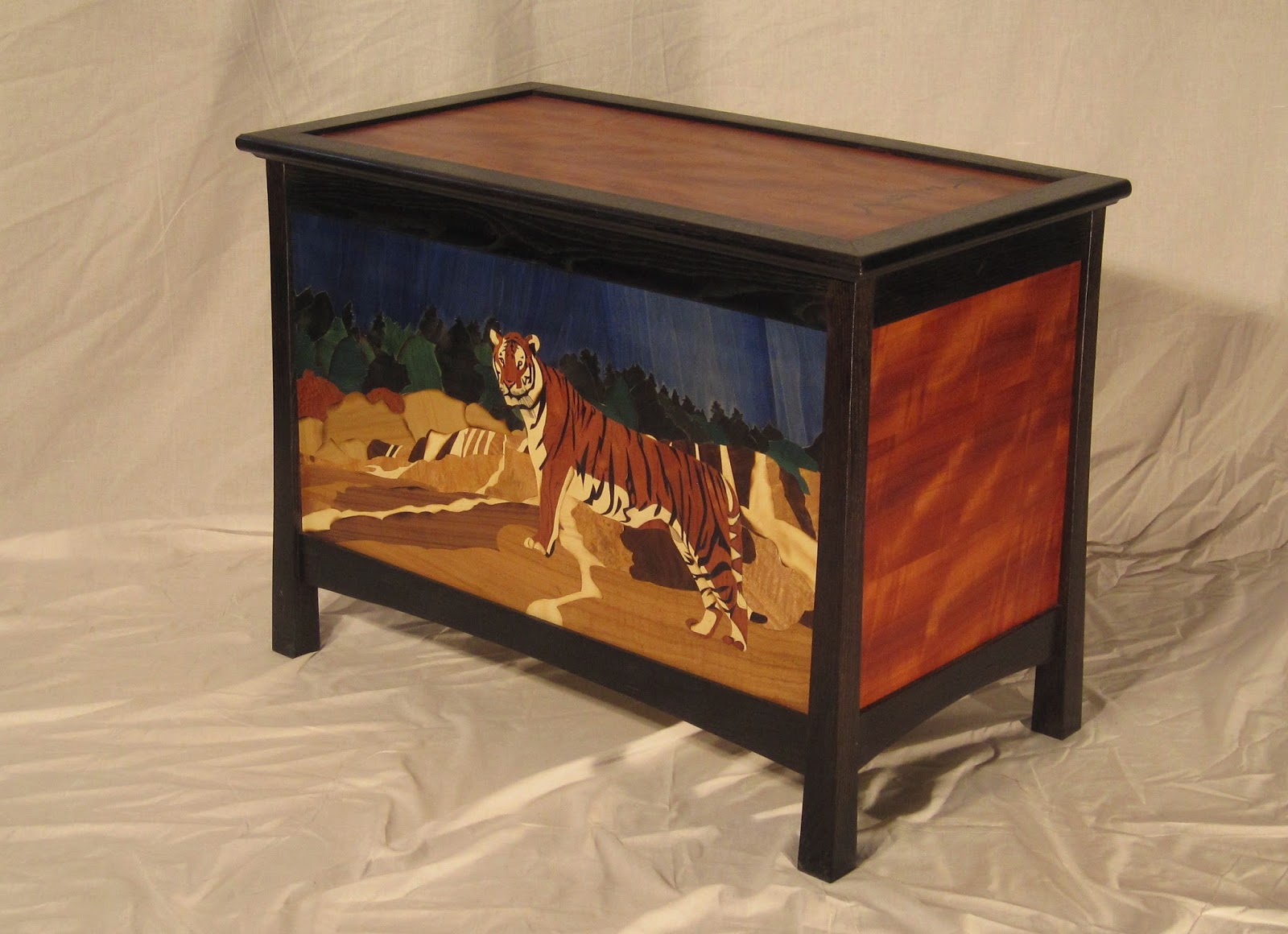I have finally found some time to post the end results of the tiger chest I have been working on. I thought I had taken more pics of the case construction but I was mistaken. The case construction was pretty straight forward and done similar to the last blanket chest I did (June 2013.) One of the few changes I made was to use red cedar veneer on the inside of the chest so with the solid cedar bottom the whole inside was done in cedar. The outside was done with Makore veneer.
The panels where pretty easy to glue up using a vacuum press but the front panel did take a little bit of time to clean all the veneer tape off and get sanded.
As with the last chest I also did all the finishing before glue-up. This takes a little more effort but I think I get a much better end result also I can fix any flaws in the finish a lot easier with the parts broken down.Below is a picture of the chest during a dry run on the glue -up but before the finishing.
 |
| dry run with no frame on the lid |
|
|
|
|
|
I needed to dry run the chest to get an accurate measurement for the lid.
I was looking for an Asian look for this chest so I thought I would ebonize the oak frame part's with the solution made from steel wool and vinegar. I added tree bark tea (quebarcho extract) before the vinegar which gives the wood a bit more tannin, the tannin in wood mixed with metal is what makes it turn black. The process is fully explained in
an article from Popular Woodworking
Ebonizing Wood.
 |
| After adding the quebarcho extract |
 |
| After ebonizing |
 |
| side frame parts drying after vinegar, notice the different color as the top pieces where done first. |
All the parts where finished with lacquer except the red cedar interior which I left unfinished. I was a little concerned about only finishing one side of a panel but after doing some research I found it was acceptable to do if your not gluing the veneer with a glue that is susceptible to moister, as it was I used unibond 800 and it is not.
The chest was only slightly out of square when I put the clamps on it so one clamp across diagonally did the trick bringing it back to square. I used a piano hing for the top and leather to keep the lid from swinging to far back.
The lid has the characters for the Chinese proverb "Three Men Make A Tiger".
Three men make a tiger
is a Chinese proverb that refers to the idea that if an unfounded
premise or urban legend is mentioned and repeated by many individuals,
the premise will be erroneously accepted as the truth. This concept is
analogous to communal reinforcement or the sociological concept known as
argumentum ad populum (appeal to the people).
The proverb came from the story of an alleged speech by Pang Cong, an
official of the state of Wei in the Warring States Period (475 BC – 221
BC) in Chinese History.
According to the Warring States Records, before he left on a trip to
the state of Zhao, Pang Cong asked the King of Wei whether he would
hypothetically believe in one civilian’s report that a tiger was roaming
the markets in the capital city, to which the King replied no. Pang
Cong asked what the King thought if two people reported the same thing,
and the King said he would begin to wonder. Pang Cong then asked, “what
if three people all claimed to have seen a tiger?” The King replied that
he would believe in it.
Pang Cong reminded the King that the notion of a live tiger in a
crowded market was absurd, yet when repeated by numerous people, it
seemed real.
As a high-ranking official, Pang Cong had more than three opponents
and critics; naturally, he urged the King to pay no attention to those
who would spread rumors about him while he was away.
“I understand,” the King replied, and Pang Cong left for Zhao.
Yet, slanderous talk took place. When Pang Cong returned to Wei, the King stopped seeing him.

.jpg)
.jpg)
.jpg)
.jpg)
.jpg)



.jpg)
.jpg)
.jpg)


.jpg)












.jpg)

.jpg)



























